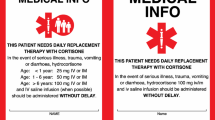Abstract
The adrenal cortex secretes glucocorticoids (GC), mineralocorticoids (MC) and androgens. GC maintain homeostasis, MC regulate fluid and electrolyte balance and adrenal androgens contribute to development of secondary sexual characteristics. Pharmacologic GC therapy is frequently indicated in the pediatric age group. Besides having many important side effects, prolonged high dose systemic GC therapy has a suppressive effect on endogenous steroid production. Therefore, GC therapy should be withdrawn gradually and stopped based on assessment of hypothalamo-pituitary-adrenal (HPA) axis recovery. Patients with HPA axis suppression require physiological replacement of GC along with enhancement of doses during periods of stress. Due to its immunosuppressive effects, issues about safety and efficacy of live virus vaccines in patients receiving systemic high dose GC therapy must be borne in mind.
Similar content being viewed by others
References
Axelrod L. Glucocorticoid therapy. In DeGroot LJ, Jemeson JL, de Kretser D, Grossman AB, Marshall JC, Melmed S et al. eds. Endocrinology, 5th ed. Philadelphia: Elsevier Saunders; 2006; 2329–2342.
Schimmer BP, Parker KL. Adrenocorticotropic hormone; Adrenocortical steroids and their synthetic analogs; inhibitors of the synthesis and actions of Adrenocortical hormones. In Brunton LL, Silazo J, Parker KL, eds. Goodman and Gilman’s The Pharmacological basis of Therapeutics, 11th ed. USA; The McGraw-Hill Companies, 2006; 1587–1612.
Kerrigan JR, Veldhuis JD, Leyo SA, Iranmanesh A, Rogol AD. Estimation of daily cortisol production and clearance rates in normal pubertal males by deconvolution analysis. J Clin Endocrinol Metab 1993; 76: 1505–1510.
Esteban NV, Loughlin T, Yergey AL, Zawadzki JK, Booth JD, Winterer JC et al.. Daily cortisol production rate in man determined by stable isotope dilution/mass spectrometry. J Clin Endocrinol Metab 1991; 72: 39–45.
Linder BL, Esteban NV, Yergey AL, Winterer JC, Loriaux DL, Cassorla F. Cortisol production rate in childhood and adolescence. J Pediatr 1990; 117: 892–896.
Shulman DI, Palmert MR, Kemp SF; Lawson Wilkins Drug and Therapeutics Committee. Adrenal insufficiency: still a cause of morbidity and death in childhood. Pediatrics 2007; 119: e484–494. Epub 2007 Jan 22.
Lukert BP. Editorial: glucocorticoid replacement-how much is enough? J Clin Endocrinol Metab 2006; 91: 793–794.
Clayton PE, Miller WL, Oberfield SE, Ritzén EM, Sippell WG, Speiser PW; ESPE/ LWPES CAH Working Group. Consensus statement on 21-hydroxylase deficiency from the European Society for Paediatric Endocrinology and the Lawson Wilkins Pediatric Endocrine Society. Horm Res 2002; 58: 188–195.
Merke DP, Bornstein SR. Congenital adrenal hyperplasia. Lancet 2005; 18–24; 365(9477): 2125–2136.
Maguire AM, Ambler GR, Moore B, McLean M, Falleti MG, Cowell CT. Prolonged hypocortisolemia in hydrocortisone replacement regimens in adrenocorticotrophic hormone deficiency. Pediatrics 2007; 120: 164–171.
American Academy of Technical report: congenital adrenal hyperplasia. Section on Endocrinology and Committee on Genetics. Pediatrics 2000; 106: 1511–1518.
Weise M, Drinkard B, Mehlinger SL, Holzer SM, Eisenhofer G, Charmandari E et al.. Stress dose of hydrocortisone is not beneficial in patients with classic congenital adrenal hyperplasia undergoing short-term, high-intensity exercise. J Clin Endocrinol Metab 2004; 89: 3679–3684.
Paton J, Jardine E, McNeill E, Beaton S, Galloway P, Young D et al.. Adrenal responses to low dose synthetic ACTH (Synacthen) in children receiving high dose inhaled fluticasone. Arch Dis Child 2006; 91: 808–813. Epub 2006 Mar 23.
Einaudi S, Bertorello N, Masera N, Farinasso L, Barisone E, Rizzari C et al.. Adrenal axis function after high-dose steroid therapy for childhood acute lymphoblastic leukemia. Pediatr Blood Cancer 2008; 50: 537–541.
Felner EI, Thompson MT, Ratliff AF, White PC, Dickson BA. Time course of recovery of adrenal function in children treated for leukemia. J Pediatr 2000; 137: 21–24.
Shah RC, Shah NK, Kukreja S. Immunization in Special Circumstances. In Shah RC, Shah NK, Kukreja S eds. IAP Guide Book on Immunization, 4th ed. Mumbai: Indian Academy of Pediatrics; 2007; 52–58.
Centers for Disease Control and Prevention. Recommendations of the Advisory Committee on Immunization Practices (ACIP): Use of vaccines and immune globulins in persons with altered immunocompetence. MMWR 1993; 42 (No.RR-4): clusive page numbers.
Author information
Authors and Affiliations
Corresponding author
Rights and permissions
About this article
Cite this article
Gupta, P., Bhatia, V. Corticosteroid physiology and principles of therapy. Indian J Pediatr 75, 1039–1044 (2008). https://doi.org/10.1007/s12098-008-0208-1
Received:
Accepted:
Published:
Issue Date:
DOI: https://doi.org/10.1007/s12098-008-0208-1




